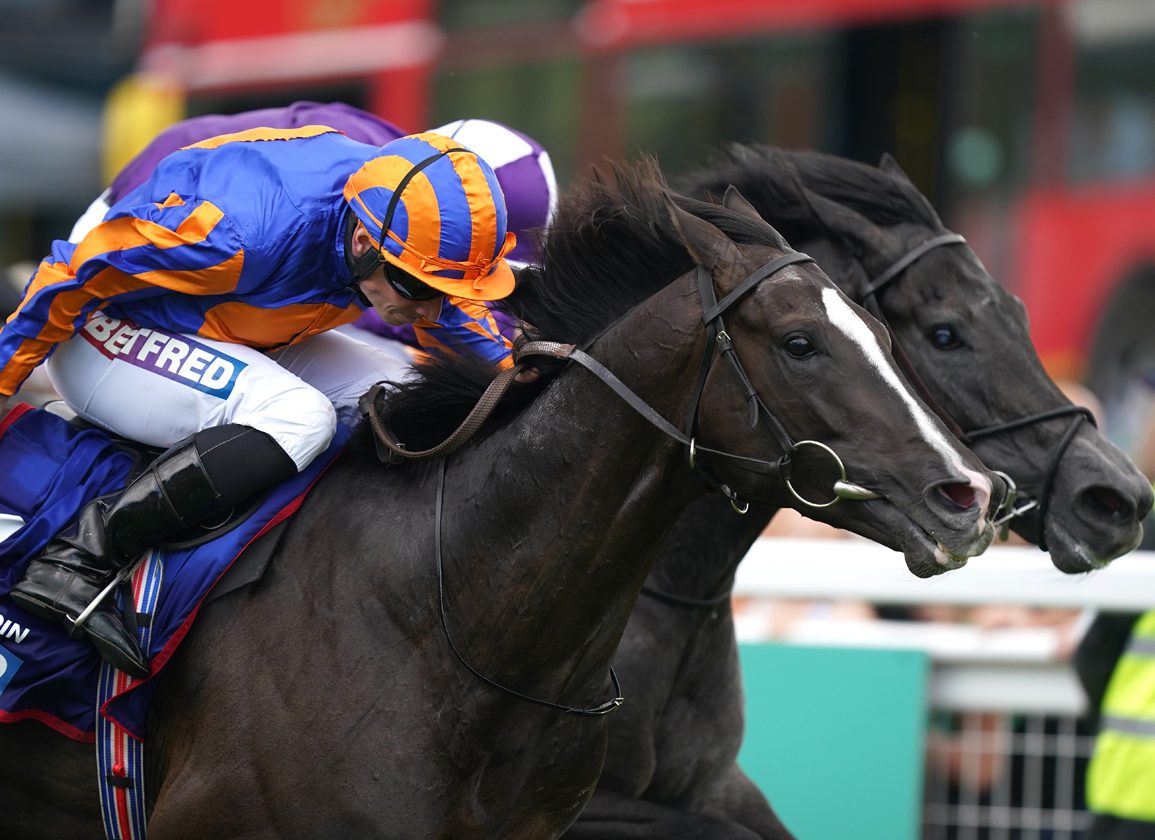Horse Racing Betting Programs 101

Written by: Chris Adams
Last Updated: Tue Jan 09, 2024, 15:25 PM
Read Time: 9 minutes
In the thrilling world of horse racing, decoding past performances is akin to unraveling a captivating mystery. These records serve as the roadmap to a horse’s journey on the track, offering invaluable insights for those astute handicappers.
Using Past Performances
As a handicapper it is important not just to read what exists on the page, but also to identify the signal it represents for the horse’s next performance. After all it is easy to determine who ran the best last race, but your wagering dollar must be focused on who is most likely to run the best race in today’s race under today’s conditions.
This comprehensive guide will explore every facet of past performances, shedding light on why each element is crucial for crafting a winning betting strategy.
Speed Figures

Auguste Rodin’s was the top speed figure holder in 2023
Speed figures remain a cornerstone of past performances. These numerical representations of a horse’s speed provide a quick snapshot of its recent form, helping bettors gauge its competitive edge.
These figures take the horse’s final time and adjust it based on the condition and speed of the track. In theory this means that an 87 earned in dirt sprint, turf route, and all-weather sprint should be the same.
It is important to remember however, that even though the numbers may be the same, a horse who earned an 87 in a turf sprint on a firm course could potentially run much better or worse if they are switching to a dirt route over a sloppy track.
Players will want to pay specific attention to the horse’s speed figures earned over the same distance and surface as today’s race. It can also be wise to look at the horse’s figures earned in the last couple of recent starts to find any potential trends in form.
Class Ratings
Class is a vital part of any handicapping puzzle. Handicappers must scrutinize a horse’s performance against varying levels of competition. Understanding how a horse fares against different classes aids in predicting its chances in upcoming races.
Some past performances will provide a specific class or race rating that is meant to be a guide on how tough the competition of the race was. There are also some hints that you can take from the conditions of the race.
Generally speaking in American flat racing there is a hierarchy of classes. It is also important to note however, that there are a lot of conditions that can be added to these classes that make it much more nuanced to determine a horse’s class.
Classes

Most handicappers accept the fact that a move up in the same column is a step up in class, but the biggest jump in class is moving from the non-winner ranks column into the winner ranks. For a more in-depth review of the class levels, check out our comprehensive class guide.
Running Style:
Beyond identifying a horse’s preferred running style, handicappers analyze how it adapts to different race scenarios. This includes assessing its ability to lead the pack, close in on frontrunners, or strategically navigate the field.
Adding to the complication of run style it is important to establish the run styles of each runner in the race. Once a pace scenario has been established, a handicapper must determine how it will impact a horse’s chances.
Pace Makes the Race

Rich Strike was one of the most prominent examples of pace scenario elevating an inferior talent when he won the 2022 Kentucky Derby.
If a race has three horses that all like to be in front there is a good chance that the pace could get extremely quick up front and allow for closers to fly by tiring horses in the stretch. In this situation all early runners may be eliminated from contention.
In the same race if 2 of the projected lead horses scratch out, the pace scenario will completely change. Now the horse that likes to take the lead may have an easy time. Horses with more talent that like to close from the back may be completely eliminated.
Jockey and Trainer Stats
Past performances will often show stats regarding the success of jockeys and trainers. These human connections are vital parts of the horse’s preparation.
The trainer, like the head coach in the NFL, is responsible for the race day preparations and general race strategy. Meanwhile the jockey serves the role of the offensive and defensive coordinator, making real time decisions about in-race strategy.
As with any NFL franchise it is important that these members of the team work together in unison to produce the best product.
It is also important to remember that despite all of the preparation and maneuvering of the humans involved, the horse is still the one that runs the race. A top flight trainer and jockey are still likely to lose 7 or 8 out of every 10 races so the importance of this factor needs to be carefully weighed.
Post Position

Examining post positions involves considering horses’ success from each gate. Depending on the track and configuration some posts may be extremely advantageous while others can be an absolute death sentence to the horse’s chances.
At any track it is important to find any emerging trends at today’s distance and surface that may indicate the type of performance we can expect today. This is especially important if your horse is breaking from “the rail” or post #1 or if they have drawn well to the outside in a big field.
Post + Run Style
More advanced players will be able to look at post position in combination with run style. If horse #12 needs the lead but will have to use a lot of energy to clear all other runners and get to the rail, this could hurt his chances despite being more talented on paper.
Inversely, a horse who likes to sit just off the pace and draws the 7 post in a race that projects to have a blistering speed duel from posts 1, 2, and 6 may get an upgrade. The inside three will sprint each other into submission while our less talented runner sits in behind and gets the jump as the pace melts down.
Pedigree
The ancestry of a horse, or its pedigree, is a critical factor. Past performances offer insights into the bloodline, revealing if a horse comes from a lineage known for excelling on certain surfaces or at specific distances.
Many modern past performances will assign breeding ratings based on the horse’s sire, dam, and dam sire. These ratings can be extremely helpful when looking at a first time starter or a horse trying to do something for the first time.
Records at Distance and Surface
Understanding a horse’s performance history at different distances and surfaces is paramount. Some horses thrive in sprints, while others exhibit their best form in longer races or on turf versus dirt.
There may also be track configurations that play better to a horse. For example, some horses prefer the 1 turn mile found at Belmont Park, while others may be more successful around the two turn mile at Gulfstream Park.
Recent Results
Beyond simply knowing if a horse won or lost, handicappers delve into recent results, including final placings and beaten lengths. This information provides a more detailed picture of a horse’s recent performances and its current state of competitiveness.
Perhaps a horse is light on speed figures but went from non-competitive efforts 2 and 3 races back to a much closer finish in the last event. This may be a signal that a horse is starting to round into form.
Many longshot plays can be found in these runners that have muddied up form, but are about to run to their best.
Claim Information
For horses that have changed ownership through claiming races, past performances reveal these transitions. Changes in ownership can impact a horse’s training regimen, which is crucial information for handicappers.
Moving from a high percentage barn to a lower one can mean that the horse will regress to a lower figure, but a horse going to a barn that is known for improving claimers could take the horse to a new top figure.
Workout History
The workout history of a horse provides insights into its fitness and readiness for an upcoming race. Consistent, well-timed workouts indicate a horse in good form and potentially ready for a strong performance.
Free Information on Wagering Sites
Many online wagering sites offer this wealth of past performance information for free with a registered account. Take advantage of these resources to elevate your handicapping game without breaking the bank. Betting News has reviews of many of the top online racebooks for those looking to maximize promotions and open a new account.
- Trusted Online Sportsbooks
-
 BetOnline Sportsbook Review »
BetOnline Sportsbook Review »
-
 SportsBetting Sportsbook Review »
SportsBetting Sportsbook Review »
-
 Bovada Sportsbook Review »
Bovada Sportsbook Review »
-
 SportBet Sportsbook Review »
SportBet Sportsbook Review »
-
 BetWhale Sportsbook Review »
BetWhale Sportsbook Review »
-
 MyBookie Sportsbook Review »
MyBookie Sportsbook Review »
-
 BetUS Sportsbook Review »
BetUS Sportsbook Review »
-
 BetDSI Sportsbook Review »
BetDSI Sportsbook Review »
-
 Everygame Sportsbook Review »
Everygame Sportsbook Review »
-
 Bookmaker Sportsbook Review »
Bookmaker Sportsbook Review »
-
 WagerWeb Sportsbook Review »
WagerWeb Sportsbook Review »
Betting News Past Performance Data
Many of the crucial aspects of the past performances can be found on Betting News. Click on any track for the day of racing and get access to all of the following tools:
- Class, speed, and pace graphs
- Winning profile scatter plot
- Jockey and trainer name with links to overall stats
- Career record and recent start information
- Run style profiles
- Expert selections
- Track bias profiles
Free Horse Racing Picks!
- Trusted Sites for Betting on Horse Racing
-
 BetOnline Racebook Review »
BetOnline Racebook Review »
-
 MyBookie Racebook Review »
MyBookie Racebook Review »
-
 Bovada Racebook Review »
Bovada Racebook Review »
-
 BetUS Racebook Review »
BetUS Racebook Review »
-
 SportsBetting Racebook Review »
SportsBetting Racebook Review »
-
 BetDSI Racebook Review »
BetDSI Racebook Review »
-
 WagerWeb Racebook Review »
WagerWeb Racebook Review »
More Horse Racing Betting Tips & Guides!
Free Betting Picks